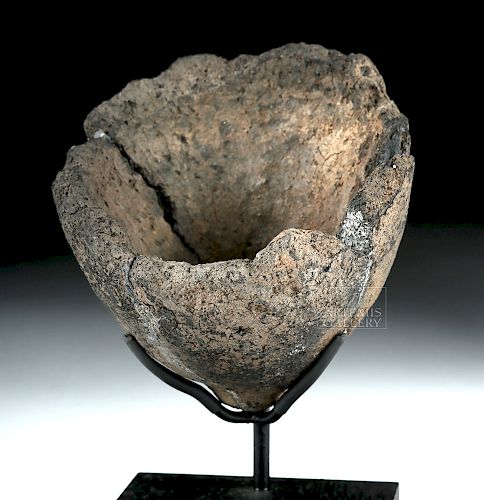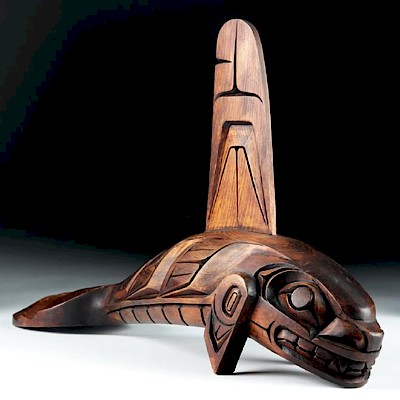Incredibly Rare Ancient Thule Culture Pottery Bowl
Lot 1a
About Seller
Artemis Fine Arts
686 S Taylor Ave, Ste 106
Louisville, CO 80027
United States
Selling antiquities, ancient and ethnographic art online since 1993, Artemis Gallery specializes in Classical Antiquities (Egyptian, Greek, Roman, Near Eastern), Asian, Pre-Columbian, African / Tribal / Oceanographic art. Our extensive inventory includes pottery, stone, metal, wood, glass and textil...Read more
Estimate:
$750 - $1,000
Absentee vs Live bid
Two ways to bid:
- Leave a max absentee bid and the platform will bid on your behalf up to your maximum bid during the live auction.
- Bid live during the auction and your bids will be submitted real-time to the auctioneer.
Bid Increments
| Price | Bid Increment |
|---|---|
| $0 | $25 |
| $300 | $50 |
| $1,000 | $100 |
| $2,000 | $250 |
| $5,000 | $500 |
| $10,000 | $1,000 |
| $20,000 | $2,500 |
| $50,000 | $5,000 |
| $100,000 | $10,000 |
| $200,000 | $20,000 |
About Auction
By Artemis Fine Arts
May 24, 2018
Set Reminder
2018-05-24 10:00:00
2018-05-24 10:00:00
America/New_York
Bidsquare
Bidsquare : Northwest Coast, Tribal, & Pre-Columbian Art
https://www.bidsquare.com/auctions/artemis-gallery/northwest-coast-tribal-pre-columbian-art-3238
Featuring Pacific Northwest Coast Native American Art from respected collector / dealer, Joseph Alphabet. Artemis Fine Arts info@artemisfinearts.com
Featuring Pacific Northwest Coast Native American Art from respected collector / dealer, Joseph Alphabet. Artemis Fine Arts info@artemisfinearts.com
- Lot Description
Native American, western Arctic (found near Teller/Brevig Mission on the Bering Sea near Nome, Alaska), Thule period, ca. 1000 to 1700 CE. A fascinating and rare piece of low-fired black pottery, fashioned into a tapering, deep bowl with a rounded point at its base. The walls of the vessel are thick, and the varied nature of their composition (including a few seeds within the clay) is easily visible. The glazed exterior, made from a mixture of seal blood and grease (don't worry, very aged!) and fired to a nice craquelure, is still visible as a thin, almost black layer in places. Size: 3.75" W x 4" H (9.5 cm x 10.2 cm); 5" H (12.7 cm) on included custom stand.
Pre-industrial pottery production is rare outside of temperate climates; the western Arctic, with its damp, cold climate is a notable exception, with pottery being produced there from about 2500 years ago. Fuel would have been wet and experimental archaeology suggests that even experienced potters had a 50% failure rate. As a result, Thule pots were fired at very low temperatures, probably slowly dried and hardened next to a fire rather than placed directly into a hearth. Applied seal blood and oil used as slip seems to have strengthened the clay, allowing it to dry more evenly and forming a seal that made it waterproof. This piece is a very intriguing example of technological innovation adapting to difficult conditions!
Provenance: private Newport Beach, California, USA collection
All items legal to buy/sell under U.S. Statute covering cultural patrimony Code 2600, CHAPTER 14, and are guaranteed to be as described or your money back.
A Certificate of Authenticity will accompany all winning bids.
We ship worldwide and handle all shipping in-house for your convenience.
#133610Repaired from four pieces. Upper portion of the bowl is fragmentary as shown, and this item is very fragile for reasons explained in the description. Amazing preservation of some of the original glaze.Condition
- Shipping Info
-
All shipping is handled in-house for your convenience. Your invoice from Artemis Gallery will include shipping calculation instructions. If in doubt, please inquire BEFORE bidding for estimated shipping costs for individual items.
-
- Buyer's Premium



 EUR
EUR CAD
CAD AUD
AUD GBP
GBP MXN
MXN HKD
HKD CNY
CNY MYR
MYR SEK
SEK SGD
SGD CHF
CHF THB
THB
















